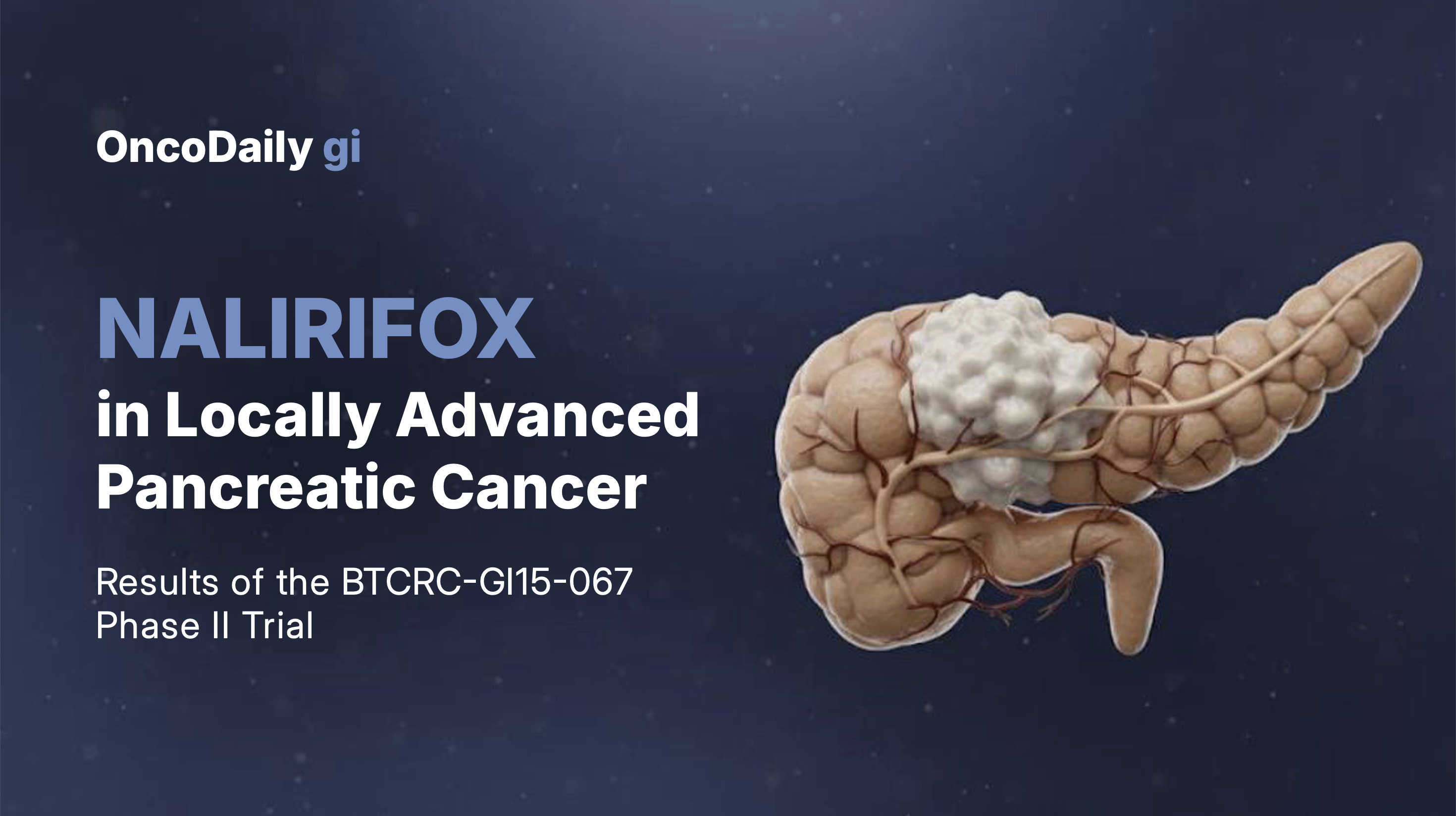Pancreatic carcinoma (PC) remains one of the deadliest cancers, ranking among the top causes of cancer-related deaths worldwide. For patients with locally advanced pancreatic carcinoma (LAPC), curative surgery is rarely possible due to tumor encasement of major blood vessels. Standard chemotherapy regimens such as FOLFIRINOX and gemcitabine plus nab-paclitaxel have improved outcomes but remain limited by toxicity and patient tolerance.
Liposomal irinotecan (nal-IRI) was developed to enhance tumor drug delivery while minimizing systemic side effects by maintaining prolonged intratumoral exposure to its active metabolite, SN-38. Building upon the success of nal-IRI in the metastatic setting (NAPOLI-1 trial), researchers from the Big Ten Cancer Research Consortium launched the BTCRC-GI15-067 phase II trial, investigating the efficacy and tolerability of NALIRIFOX—a combination of liposomal irinotecan, oxaliplatin, leucovorin, and 5-fluorouracil—as a first-line treatment for patients with locally advanced pancreatic carcinoma.
What Is Liposomal Irinotecan and How Does It Work?
Liposomal irinotecan (also known as Onivyde) is a nanoliposomal formulation of irinotecan designed to enhance tumor drug delivery and reduce systemic exposure. Encapsulation in long-circulating liposomes alters distribution kinetics, enabling sustained intratumoral exposure to irinotecan’s active metabolite SN-38 which inhibits topoisomerase I and thereby disrupts DNA replication in cancer cells.
This altered pharmacokinetic profile is thought to improve antitumor efficacy while mitigating adverse events traditionally associated with conventional irinotecan such as severe diarrhea and neutropenia.

source: ResearchGate
NALIRIFOX vs FOLFIRINOX: Key Differences in Dosing and Tolerability
Both regimens use 5-fluorouracil, leucovorin, irinotecan, and oxaliplatin, but NALIRIFOX replaces conventional irinotecan with liposomal irinotecan and uses lower nominal doses. Standard FOLFIRINOX commonly uses irinotecan 180 mg/m² and oxaliplatin 85 mg/m², whereas NALIRIFOX uses liposomal irinotecan 50 mg/m² and oxaliplatin 60 mg/m², with leucovorin 400 mg/m² and 5-FU 2,400 mg/m² (46-hour infusion) in both.
The enhanced intratumoral delivery of the liposomal formulation helps preserve antitumor efficacy while improving tolerability, and clinically is associated with fewer high-grade GI and hematologic AEs versus full-dose FOLFIRINOX—supporting use in a broader patient population.
Published in the Journal of Clinical Oncology (ASCO Annual Meeting, May 29, 2024), “Comparative Effectiveness of NALIRIFOX vs FOLFIRINOX in Pancreatic Cancer” by Xiayu Jiao and Afsaneh Barzi compared efficacy, quality of life, and cost. Using data from the PRODIGE and NAPOLI-3 trials, NALIRIFOX showed longer progression-free survival (8.9 vs 6.8 months), greater life-year gain (11.97 vs 10.95 months), and higher QALY (10.23 vs 9.59 months).
While drug costs were higher for NALIRIFOX ($13,610 vs $5,501/month), adverse event management costs were lower ($5,589 vs $15,511), reflecting improved tolerability. The model indicated better clinical outcomes for NALIRIFOX but at a higher overall economic cost (ICER $1.37M)
Trial Design
This open-label, single-arm, multicenter phase II trial enrolled patients with histologically confirmed, untreated LAPC and an ECOG performance status of 0–1. Participants received NALIRIFOX every 14 days until progression, resection, or completion of 12 cycles.
Regimen (per cycle)
- Liposomal irinotecan: 50 mg/m² IV (90 min)
- Oxaliplatin: 60 mg/m² IV (2 h)
- Leucovorin: 400 mg/m² IV (30 min)
- 5-Fluorouracil: 2,400 mg/m² IV (46 h continuous infusion)
Endpoints
- Primary: Disease control rate (DCR) at 8 weeks
- Secondary: Objective response rate (ORR), progression-free survival (PFS), overall survival (OS), resection rate, safety, CA19-9 biomarker response, and quality of life (EORTC QLQ-C30)
Tumor response was assessed by RECIST v1.1, and statistical design followed Simon’s two-stage minimax model targeting a 75% DCR versus a 45% historical control (power 80%, α = 0.05).
Results
A total of 28 patients were enrolled across four U.S. academic centers, with 26 evaluable for efficacy. The average patient age was 65 years, with 35% women and 65% men enrolled. The cohort was racially diverse, including 85% White, 12% Asian, and 4% Black participants.
The disease control rate at eight weeks was 73.1% (95% CI, 52.2–88.4), surpassing the predefined benchmark. The objective response rate reached 16% at eight weeks, 21% at sixteen weeks, and 25% at twenty-four weeks, while stable disease was maintained in more than 80% of patients across all time points. Notably, two patients (9.5%) achieved surgical resection, including one near-complete pathological response, indicating the potential for tumor downstaging with this regimen.

Biochemical responses mirrored radiologic outcomes. Serum CA 19-9 levels decreased in 72% of evaluable patients, and this decline significantly correlated with tumor response (p = 0.012). With a median follow-up of 21 months, median progression-free survival was 8.1 months (95% CI, 5.2–12.1), and median overall survival was 18 months (95% CI, 11.3–22.5). The 24-month overall survival rate reached 40%, reflecting encouraging long-term disease control in this challenging population.
Safety Profile
The NALIRIFOX regimen demonstrated manageable safety consistent with expectations for its components. Across 970 adverse events reported, only 7.4% were grade ≥3. The most frequent severe event was diarrhea, followed by hypertension, neutropenia, and fatigue. Serious adverse events occurred in eight patients (28.6%), yet no treatment-related deaths were observed. Treatment discontinuation due to toxicity was rare (<1%). Compared with FOLFIRINOX, the liposomal irinotecan formulation appeared to reduce the incidence and severity of gastrointestinal and hematologic toxicities, highlighting its tolerability advantage for patients with borderline performance status.
Quality of Life Outcomes
Quality-of-life assessments showed no significant deterioration in global health or functional status during treatment. Patients reported marked improvements in pain, appetite, and constipation, while diarrhea temporarily worsened during therapy but resolved afterward. These findings suggest that NALIRIFOX can achieve effective tumor control without compromising patient well-being—a key consideration in the palliative management of LAPC.
Conclusion
The BTCRC-GI15-067 phase II trial, published in JCO Oncology Advances, provides evidence that the NALIRIFOX regimen offers a compelling balance between efficacy and tolerability for patients with locally advanced pancreatic carcinoma. With a 73% disease control rate, 8-month median PFS, and 18-month median OS, this liposomal irinotecan-based therapy compares favorably with traditional FOLFIRINOX while offering improved safety and sustained quality of life.
These results position NALIRIFOX as a promising frontline strategy for LAPC, particularly for patients unable to tolerate conventional chemotherapy intensity. Future phase III trials will be essential to confirm these findings and potentially redefine the therapeutic standard for this difficult-to-treat diseas.
